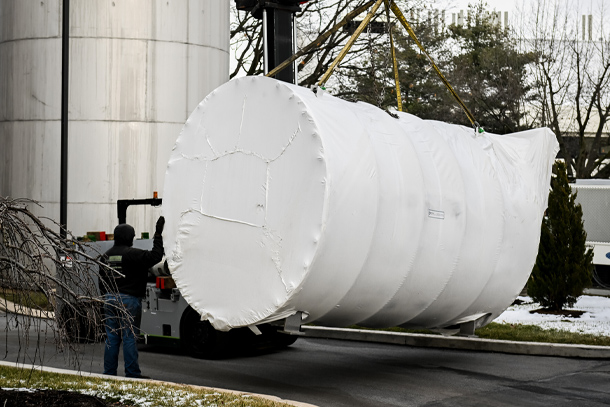
The Penn State Radiation Science and Engineering Center (RSEC) recently received a small angle neutron scattering (SANS) device. The arrival of the equipment makes Penn State the first and only U.S. university research reactor to have SANS capability, according to RSEC researchers. Credit: Poornima Tomy/Penn State
New device positions Penn State at the forefront of university research reactors
March 14, 2024
By Sarah Small
UNIVERSITY PARK, Pa. — The Penn State Radiation Science and Engineering Center (RSEC) recently received a small angle neutron scattering (SANS) device, a $9.8 million equipment donation from Helmholtz Zentrum Berlin (HZB) in Germany. The arrival of the SANS equipment makes Penn State the first and only U.S. university research reactor to have SANS capability, according to RSEC researchers.
“Transporting the SANS instrument was a challenging task,” said Daniel Beck, engineering program manager at RSEC. “It’s a complex device, and, at 32 meters long, it required eight shipping containers to transport. It took almost two years for dismantling, packaging and radiation surveying. Now we are in the process of modifications and installation at RSEC.”
According to the RSEC researchers, SANS is an important technique for determining structure in organic materials such as polymers, complex fluids and biomolecules. In these materials, the lack of heavy elements and electron density contrast creates challenges for traditional x-ray techniques. The neutron scattering from the nucleus provides detailed information that cannot be obtained through traditional methods.
“The installation of the SANS will have impact campus-wide and beyond, increasing research possibilities at RSEC and its Breazeale Reactor for cutting-edge research in materials, energy sustainability and biological sciences,” said Kenan Ünlü, director of RSEC and professor of nuclear engineering. “We are very grateful for this generous gift from HZB of the equipment and handling of the shipping so that researchers from around the country and world can advance scientific knowledge and discovery through work done at Penn State’s facilities.”
The Penn State Radiation Science and Engineering Center (RSEC) recently received a small angle neutron scattering (SANS) device, a $9.8 million equipment donation from Helmholtz Zentrum Berlin (HZB) in Germany. The arrival of the SANS equipment makes Penn State the first and only U.S. university research reactor to have SANS capability, according to RSEC researchers. Credit: Tyler Henderson/Penn State
Ünlü anticipates that the SANS equipment will be used for collaborative research across the University by faculty and students in the College of Engineering, the College of Earth and Mineral Sciences, Eberly College of Sciences, Materials Research Institute, the Huck Institutes of Life Science and the Institute for Computational and Data Sciences. The SANS equipment will be used through the national Nuclear Science User Facilities (NSUF) program at Penn State, which will allow for instrument and experiment development by industry, national laboratories and other university researchers.
A 2022 expansion of RSEC enabled the simultaneous operation of up to seven neutron beam lines in the reactor. One of these lines is designated for the SANS device, which can analyze structures between a few to hundreds of nanometers — a nanometer is one billionth of a meter — making it possible to study samples in a variety of fields at very small scale.
The instrument will enable two research options in one beam line: continuous neutrons and pulsed neutrons. Both approaches allow researchers to measure how neutrons scatter when they interact with a variety of sample materials, as well as control which parameters the researchers choose to track such as the dynamics of a variety of materials, the mechanisms of protein preservation and the relationship between nanoscale structure and bulk properties when investigating different aspects of the samples.
“The goal of HZB is that its neutron scattering instruments will continue to be available for research and innovation after the shutdown of the neutron source BER II in 2019,” said Roland Steitz, project manager of instrument transfer at HZB. “Starting from Professor Ünlü’s first visit at HZB back in 2018 and initial discussions on the taking over of the [SANS instrument], many measures were successfully taken in joint action. We are very pleased that with the arrival of the SANS instrument at Penn State, another major milestone of this important project is accomplished on its way to reinstallation at the Breazeale reactor. We very much appreciate all the efforts undertaken from Penn State in this important cooperation, and we wish the small angle neutron scattering instrument a bright and prosperous future at its new home. The German and HZB’s small angle scattering communities are already awaiting the chances to come for joint projects.”
“It is an exciting time for neutron science at Penn State,” Ünlü said. “New and improved facilities including the installation of SANS will open new frontiers for neutron science at Penn State.”



